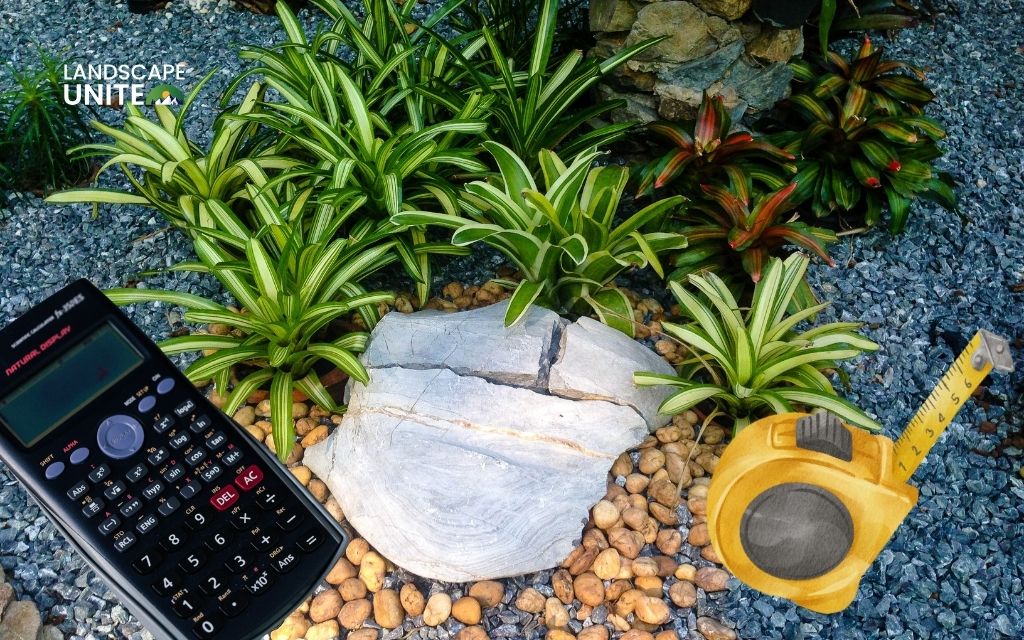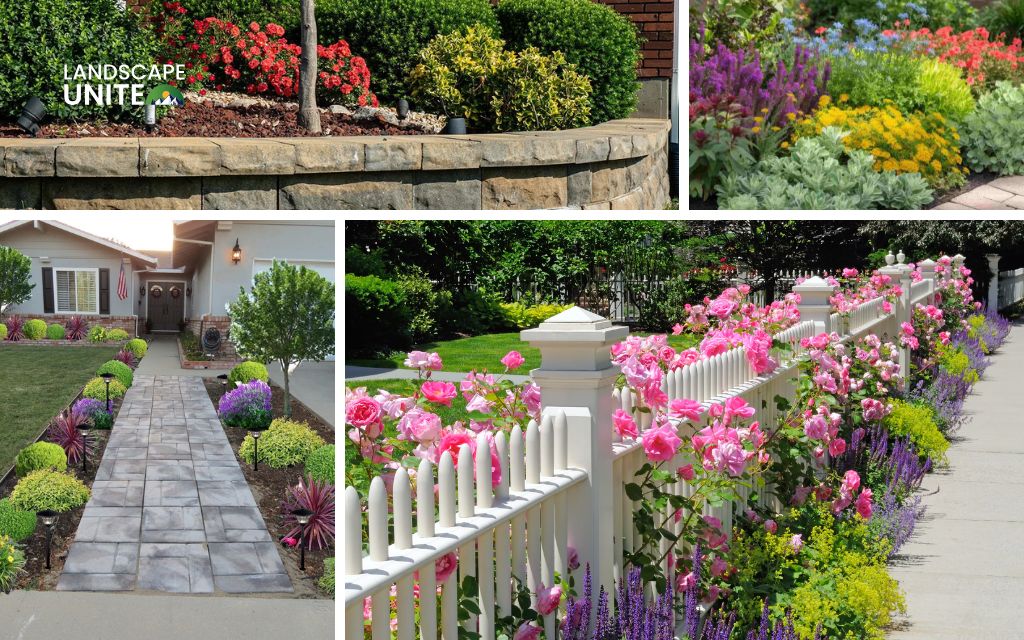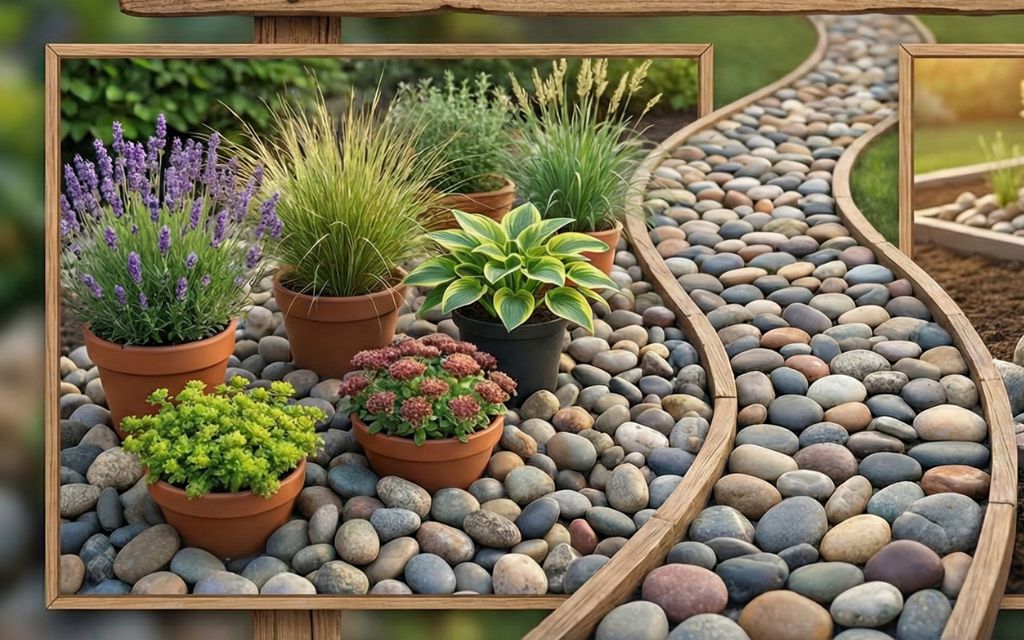Thinking about using rubber mulch in your flower beds? You’re not alone. Thousands of homeowners are drawn to its promise of low maintenance, vibrant color, and decade-long durability. But before you invest, it’s crucial to understand both the benefits and potential drawbacks of this controversial landscaping material.
Rubber mulch, made from recycled tires, has sparked heated debates among gardeners and landscaping professionals. While manufacturers tout its longevity and weed control, critics raise concerns about chemical leaching, plant health, and environmental impact. So, what’s the truth?
In this comprehensive guide, we’ll explore everything you need to know about rubber mulch in flower beds. From installation tips and cost comparisons to safety concerns and eco-friendly alternatives, we’ll help you make an informed decision that suits your landscape and lifestyle. Whether you’re weighing rubber against organic options or searching for the best solution for your garden, you’ll find the answers you need right here.
What is rubber mulch? (Understanding the basics)
Rubber mulch is ground cover made from recycled rubber tires, shredded into small chips or nuggets for use in landscaping and flower beds. This innovative material transforms what would otherwise be landfill waste into a functional landscaping product, appealing to homeowners looking for sustainable solutions.
The manufacturing process involves several steps. First, old tires are collected and processed to remove steel belts and other metal components. Then, the rubber is shredded into various sizes, from fine chips to larger nuggets. Finally, many products undergo a color-coating process to create the vibrant hues you see at garden centers.
Types of rubber mulch:
| Type | Size | Best Used For | Appearance |
| Nuggets | Larger, chunky pieces | Pathways and play areas | Textured, bold look |
| Chips | Medium-sized pieces | Flower beds and borders | Balanced coverage and appeal |
| Shreds | Fine, small pieces | Maximum ground coverage | Mimics traditional wood mulch |
Originally developed for playground surfaces where its cushioning properties provided safety benefits, rubber mulch has expanded into residential landscaping. Today, you’ll see it used in pathways, around trees, and increasingly in flower beds and garden borders.
The key difference between rubber mulch and organic mulch lies in its permanence. While wood chips, pine bark, and other organic materials break down over time to enrich your soil, recycled tire mulch maintains its structure year after year. This characteristic is both its greatest selling point and its most significant limitation, depending on your gardening philosophy.
The pros of using rubber mulch in flower beds
Long-lasting durability (10-12 years)
One of the most compelling advantages of rubber mulch for flower beds is its impressive lifespan. Unlike organic mulch that decomposes and requires annual replacement, rubber mulch lasts 10-12 years without breaking down. This longevity translates to significant time and cost savings over the years.
The color retention properties are equally remarkable. While wood mulch fades to gray within months, rubber maintains its vibrant appearance throughout its lifespan. Whether you choose rich brown, deep red, natural black, or even decorative blue or green, your flower beds will look freshly mulched year after year.
Think about it this way: if you typically replace organic mulch annually, you’d need to buy and spread new mulch 10-12 times during the same period that rubber mulch remains effective. That’s a lot of weekends saved from mulching duty.
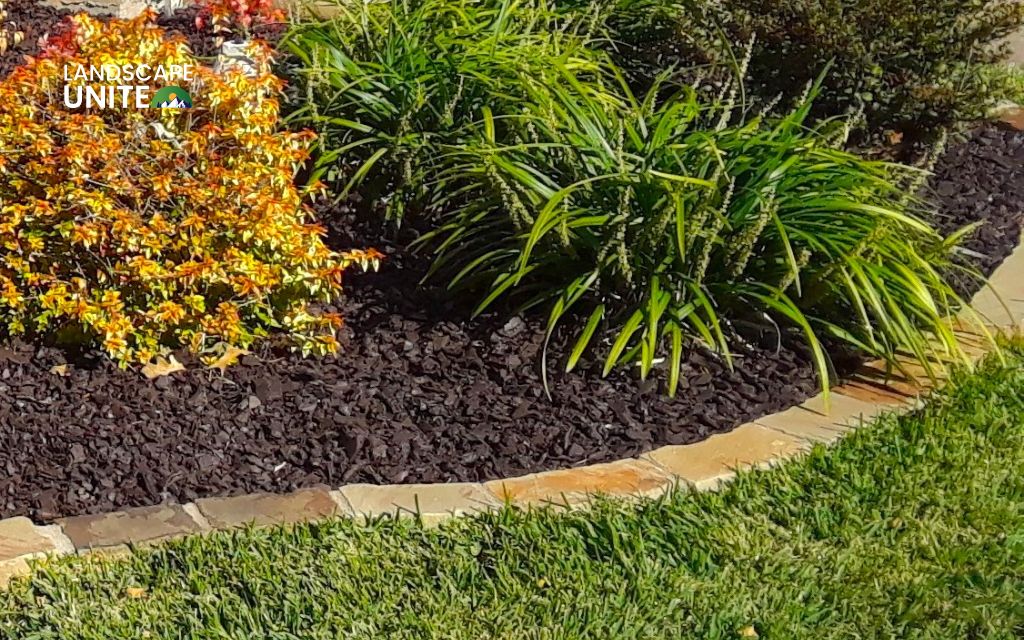
Superior weed suppression
When properly installed over landscape fabric, rubber mulch provides excellent weed control for your flower beds. The material blocks sunlight from reaching the soil surface, preventing weed seeds from germinating. Its density creates an effective barrier that’s difficult for weeds to penetrate.
Compared to organic mulch, which can actually become a growing medium for weeds as it decomposes, rubber maintains its weed-blocking properties indefinitely. However, keep in mind that while rubber mulch significantly reduces weeds, it doesn’t eliminate them entirely. Seeds blown onto the surface can still germinate, and persistent perennial weeds may push through if the fabric layer underneath isn’t properly installed.
For maximum weed control, combine rubber mulch with quality landscape fabric and maintain a consistent depth of 2-3 inches throughout your flower beds.
Low maintenance requirements
Is rubber mulch good for busy homeowners? Absolutely, when it comes to maintenance. Once installed, rubber mulch requires minimal upkeep. You won’t need to replenish it annually, rake it back into place constantly, or worry about it decomposing into nothing.
The benefits of rubber mulch really shine through in maintenance savings. A simple raking every few months to fluff the material and restore its appearance is typically all that’s needed. If the mulch gets dirty, you can rinse it with a garden hose. No special treatments, no regular replacement schedules, no endless trips to the garden center with a truckload of mulch bags.
This low-maintenance characteristic makes rubber mulch particularly appealing for large flower bed installations, vacation homes, or for gardeners with physical limitations that make annual mulching difficult.
Weather and erosion resistance
Rubber mulch landscape applications perform exceptionally well in various weather conditions. Unlike lightweight wood chips that wash away during heavy rains or blow around in strong winds, rubber mulch stays put better than most organic alternatives.
The material doesn’t decompose when exposed to moisture, making it ideal for areas with high rainfall or humidity. It won’t form mold, fungus, or attract the decomposition process that organic mulches undergo. In regions with dramatic temperature swings, rubber mulch maintains its integrity without freezing solid or turning to mush.
That said, it’s worth noting that when rubber mulch is completely dry, its lightweight nature can become a disadvantage in extremely windy conditions. However, once settled and slightly compacted, it typically remains stable.
Vibrant color options
The aesthetic flexibility of rubber mulch is undeniable. Available in black, brown, red, blue, green, and various natural tones, you can match virtually any landscaping design vision. This range allows you to create striking contrasts or harmonious blends with your home’s exterior and surrounding landscape.
Black rubber mulch provides a sleek, modern look that makes colorful flowers pop. Brown varieties offer a natural appearance that mimics traditional wood mulch. Red tones can complement brick homes beautifully, while creative gardeners might use blue or green for unique design statements.
The color consistency over many years means your carefully planned color scheme won’t fade and change the way organic mulch does. Your flower beds will maintain their designed appearance season after season.
The cons and concerns about rubber mulch
Quick reference: Major concerns at a glance
| Concern | Impact Level | Why It Matters |
| Chemical leaching | High | Zinc, benzene, PAHs can harm plants and contaminate soil |
| Heat absorption | High | Can stress plant roots and increase water needs |
| No soil enrichment | High | Soil health declines over time without organic matter |
| Environmental impact | Medium to High | Groundwater contamination, wildlife toxicity |
| Fire risk | Medium | Flammable and burns at high temperatures |
| Drainage issues | Medium | Less water-permeable than organic options |
| Pest attraction | Low to Medium | Studies show cockroaches prefer rubber environments |
Chemical leaching and toxicity concerns
This is where the rubber mulch pros and cons conversation becomes serious. What is in rubber mulch that causes concern? The material contains chemicals from the original tires, including zinc, benzene, polyaromatic hydrocarbons (PAHs), phthalates, and volatile organic compounds (VOCs).
Research has shown that these chemicals can leach into the surrounding soil, particularly during rain or irrigation. Studies have documented that rubber leachate is extremely toxic to aquatic communities, capable of killing algae, zooplankton, snails, and fish in affected water systems. The zinc content in rubber mulch is particularly problematic, as high levels can cause chlorosis, a condition where plant leaves turn yellow due to zinc toxicity.
Is rubber mulch toxic? The answer exists in a scientific gray area. The EPA’s 2024 study found that actual exposure levels from recycled tire crumb are generally low under normal use conditions. However, this creates what experts call the EPA paradox: while measured exposure may be low, the presence of known carcinogens and toxic compounds raises legitimate concerns.
Professional horticulturists and master gardeners universally advise against using rubber mulch near vegetable gardens or any edible plants. The risk of chemical contamination in food crops is simply too significant. Even for ornamental flower beds, many experts recommend caution, particularly in areas where runoff might affect water sources.
The permanence of potential contamination adds another layer of concern. Because rubber mulch doesn’t decompose, once chemicals leach into your soil, they can remain for extended periods, making remediation difficult.
Heat absorption issues
Is rubber mulch bad for plants in hot climates? Often, yes. Rubber mulch can become significantly hotter than organic alternatives when exposed to direct sunlight. Surface temperatures can reach levels that stress nearby plant roots and create an inhospitable environment for beneficial soil organisms.
During summer months, rubber mulch in flower beds can retain heat well into the evening, preventing the natural cooling that plants need. This is particularly problematic for shallow-rooted flowers and young plants with developing root systems. The heat radiating from rubber mulch can effectively “cook” tender roots and increase water stress on your plants.
Wood mulch and other organic materials, by contrast, insulate the soil and help maintain more moderate temperatures. They actually keep soil cooler during hot weather, which is exactly what most flower bed plants prefer.
If you live in a region with hot summers or have flower beds in full sun locations, the heat absorption problem becomes a significant disadvantage worth considering carefully.
Lack of soil enrichment
One of the most significant long-term drawbacks is what rubber mulch doesn’t do. Organic mulches like wood chips, pine bark, and shredded leaves gradually decompose, adding valuable organic matter, nutrients, and beneficial microorganisms to your soil. This natural process improves soil structure, enhances water retention, and creates a healthier growing environment for your plants.
Rubber mulch provides none of these benefits. It sits on top of your soil indefinitely without contributing any nutritional value or improving soil quality. Over time, flower beds mulched with rubber may actually experience declining soil health because you’re not getting the regular organic matter additions that traditional mulching provides.
For gardeners who understand that healthy soil is the foundation of a thriving garden, this limitation is a deal breaker. You’ll need to compensate by adding compost and other soil amendments separately, which somewhat undermines the low-maintenance appeal of rubber mulch.
Environmental and wildlife concerns
The environmental impact of rubber mulch extends beyond your garden boundaries. Research shows that chemicals leaching from shredded tire mulch can contaminate groundwater and harm aquatic ecosystems. When rubber particles wash into storm drains and waterways, they carry toxic compounds that accumulate in the environment.
Wildlife concerns are equally troubling. Studies have documented that rubber mulch environments attract certain pests, particularly Asian cockroaches, which prefer these habitats over natural materials. Additionally, the chemical compounds released as rubber breaks down can affect beneficial insects, earthworms, and other garden allies that contribute to a healthy ecosystem.
From a sustainability perspective, while rubber mulch does recycle old tires, questions remain about whether this use truly represents the best environmental solution. The material doesn’t biodegrade, meaning it will eventually need disposal, potentially returning to the waste stream it was meant to escape.
For environmentally conscious gardeners, these concerns often outweigh the recycling benefits, particularly when organic alternatives offer both functionality and genuine ecological advantages.
Practical problems
Beyond the major concerns, several practical issues make rubber mulch problematic for flower beds. Despite being heavier than it looks, rubber mulch is surprisingly lightweight when completely dry. This can lead to displacement during strong winds or heavy rain events, requiring you to redistribute the material periodically.
The fire safety aspect presents another concern. While sometimes marketed as fire-resistant, rubber mulch is actually flammable. More troubling, when it does ignite, it burns at extremely high temperatures and is difficult to extinguish, posing risks in fire-prone regions or near grills and fire pits.
Water permeability is less than ideal compared to organic mulches. Rubber mulch can create drainage issues, with water sometimes pooling on the surface rather than penetrating efficiently to plant roots. This can lead to moisture-related problems for your flowers, particularly in heavy clay soils or areas with poor natural drainage.
These practical problems with rubber mulch may seem minor individually, but collectively they can create ongoing frustrations that diminish the supposedly low-maintenance benefits.
Rubber mulch vs. organic mulch: A complete comparison
Understanding the differences between rubber and organic options helps you make an informed choice. Here’s a comprehensive side-by-side comparison:
| Feature | Rubber Mulch | Organic Mulch (Wood/Bark) |
| Lifespan | 10-12 years | 1-2 years |
| Initial Cost | Higher investment | Lower upfront cost |
| Soil Benefits | None | Enriches soil as it decomposes |
| Maintenance | Minimal, occasional raking | Annual replacement needed |
| Plant Safety | Chemical leaching concerns | Safe for all plants |
| Environmental Impact | Controversial, toxicity issues | Biodegradable, eco-friendly |
| Heat Retention | Absorbs and holds heat | Insulates and cools soil |
| Weed Control | Good with fabric barrier | Moderate, decreases as it decomposes |
| Color Retention | Excellent, lasts years | Fades to gray quickly |
| Weight | Lightweight when dry | Heavier, more stable |
| Fire Risk | Flammable, burns hot | Can ignite but less dangerous |
| Water Permeability | Less permeable | Excellent drainage |
- When rubber mulch makes sense: It can work for decorative areas where plant health is less critical, such as pathways, play areas, or around non-edible ornamental features where you prioritize appearance and low maintenance over soil health.
- When organic mulch is better: For actual flower beds where you’re growing living plants, organic mulch is the superior choice. It supports plant health, improves soil quality, and creates a living ecosystem in your garden. The annual replacement, while requiring more effort, is actually a feature rather than a bug because it continuously improves your growing environment.
- Cost analysis over 10 years: While rubber mulch costs more initially, its longevity can make it cost-competitive over time if you calculate replacement costs for organic mulch. However, this purely financial comparison doesn’t account for the soil health benefits of organic mulch, which have real value for your plants’ long-term success and your garden’s productivity.
Is rubber mulch safe for flower beds? (Safety deep dive)
Plant health considerations
Does rubber mulch kill plants? Not directly, but it can significantly compromise their health. The zinc leaching from rubber mulch can cause chlorosis, where leaves turn yellow due to nutrient imbalance. High zinc levels interfere with iron uptake, creating deficiencies even when iron is present in the soil.
Heat stress on root systems presents another significant threat. During hot weather, the elevated temperatures around rubber-mulched plants can damage tender roots, increase water requirements, and slow plant growth. Flowers that are already stressed by heat become more susceptible to disease and pest problems.
Water permeability concerns also affect plant health. When water doesn’t penetrate evenly through rubber mulch, you may experience inconsistent soil moisture. Some areas stay too wet while others become too dry, making it difficult to maintain the consistent moisture that most flowering plants prefer.
The combination of these factors means that while rubber mulch won’t immediately kill your flowers, it creates a less-than-ideal growing environment that can lead to disappointing results over time.
Human and pet safety
Is rubber mulch safe for your family? The EPA’s 2024 findings suggest that exposure levels under normal use conditions are generally low. However, “generally low” doesn’t mean zero, and concerns remain about long-term exposure, particularly for children who might play near mulched areas.
The presence of known carcinogens like benzene and PAHs means that any exposure carries some level of risk, even if that risk is statistically small. For families with young children or pets who spend significant time in the yard, many experts recommend erring on the side of caution.
Pets present special considerations. Dogs and cats may ingest small amounts of rubber mulch during play, and the heat absorption properties can make mulched areas uncomfortable for pets’ paws during summer. If your pets frequently use areas near your flower beds, organic alternatives are generally safer choices.
When NOT to use rubber mulch
Certain situations absolutely call for avoiding rubber mulch:
- Vegetable gardens and edible plants – Chemical leaching risk is unacceptable where you’re growing food. This includes herbs, vegetables, and even fruit-bearing ornamentals.
- Areas with poor drainage – Rubber mulch’s water permeability issues will compound existing drainage problems and create standing water situations.
- Hot, sunny locations – Full-sun flower beds in warm climates will subject your plants to excessive heat stress from rubber’s heat absorption properties.
- Near water features or wells – Chemical runoff from rubber mulch can affect water quality in ponds, streams, or groundwater, potentially harming aquatic life and affecting drinking water sources.
- Around children’s play areas near gardens – While marketed for playgrounds, keeping it away from areas where children play near edible plants adds extra safety.
Most professional landscapers simply don’t recommend rubber mulch for flower gardens at all, reserving it exclusively for non-planting applications like playgrounds and decorative pathways.
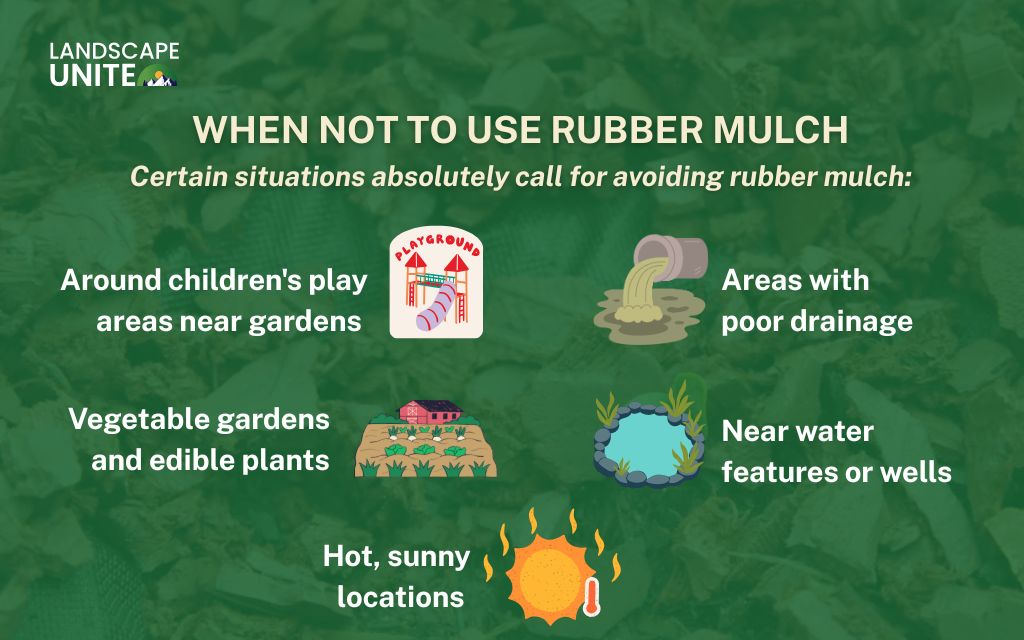
How to install rubber mulch in flower beds (Step-by-step)
Installation quick checklist:
Before you begin, gather these materials:
- Landscape fabric (professional-grade)
- Landscape staples or pins
- Rake and garden tools
- Rubber mulch (calculated amount)
- Bed edging materials
- Measuring tape
Step 1: Prepare your flower bed
Start by removing any existing mulch and clearing all weeds from the area. Take time to pull weeds by the roots rather than just cutting them at the surface. This initial effort pays dividends in long-term weed control.
Test your soil pH and nutrient levels, then amend as needed before installing the mulch. Once rubber mulch is in place, working with the soil becomes more difficult. Add compost, adjust pH, and address any drainage issues during this preparation phase.
Install or repair bed edging to contain the mulch and create clean lines. Good edging prevents rubber mulch from migrating into lawn areas and gives your flower beds a finished appearance.
Step 2: Install landscape fabric
This step is absolutely essential when using rubber mulch in flower beds. Quality landscape fabric creates a barrier between soil and mulch, dramatically improving weed control and preventing rubber particles from mixing into your soil.
Lay the fabric across the entire bed, overlapping seams by at least 6 inches. Cut X-shaped slits for existing plants, keeping the fabric snug around stems without touching them directly. Secure the fabric every few feet using landscape staples or pins, paying special attention to edges and seams.
Choose professional-grade landscape fabric rather than thin plastic sheeting. The fabric needs to allow water and air to pass through while blocking weeds and preventing direct contact between rubber and soil.
Step 3: Calculate mulch quantity
| Flower Bed Size | 2-inch Depth | 3-inch Depth |
| 100 sq ft | 0.67 cubic yards | 1.0 cubic yards |
| 200 sq ft | 1.34 cubic yards | 2.0 cubic yards |
| 300 sq ft | 2.0 cubic yards | 3.0 cubic yards |
| 400 sq ft | 2.67 cubic yards | 4.0 cubic yards |
Proper depth matters for both appearance and function. The recommended depth for rubber mulch is 2-3 inches. Too shallow provides inadequate coverage, while too deep can create drainage problems and waste money.
To calculate for custom sizes: measure your flower bed’s length and width in feet, multiply these numbers to get square footage, then use the table above or calculate approximately 0.67 cubic yards per 100 square feet for 2-inch depth. Add 10% extra to your calculations to ensure complete coverage.
Step 4: Apply rubber mulch
Pour or spread the rubber mulch evenly across the landscape fabric. Use a rake to distribute it uniformly, maintaining consistent depth throughout the bed. Work carefully around plant stems, keeping mulch 2-3 inches away from crowns and trunks to prevent moisture buildup and potential rot.
Pay attention to corners and edges, ensuring complete coverage without gaps where weeds can emerge. The mulch should look neat and even, with no bare spots of fabric showing through.
Take your time with this step. Proper spreading now saves correction work later and ensures your flower beds look professionally finished.
Step 5: Maintenance tips
Even low-maintenance rubber mulch needs occasional care. Rake the material every few months to fluff it and restore its appearance. This prevents compaction and maintains good surface texture.
Clean the mulch annually by rinsing with a garden hose to remove accumulated dust, pollen, and debris. This simple step keeps colors looking vibrant and fresh.
Check periodically for displacement, particularly after heavy storms or high winds. Add more mulch to any areas that have thinned out, maintaining the 2-3 inch depth for optimal performance. Inspect the perimeter regularly to ensure mulch hasn’t migrated beyond your bed borders.
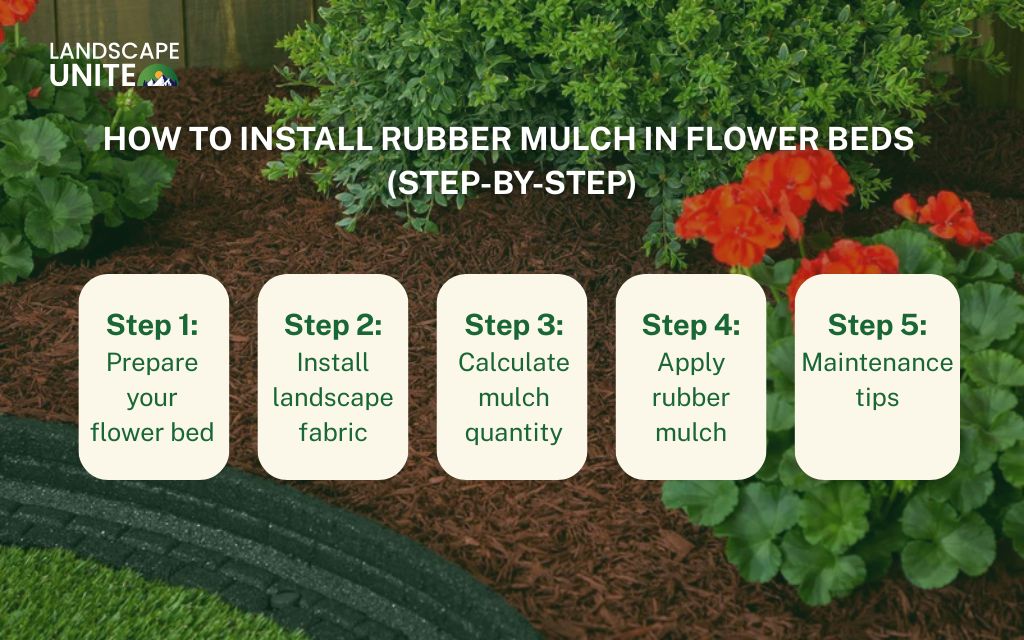
Rubber mulch cost analysis for flower beds
Understanding the financial investment helps you make informed decisions. Pricing for rubber mulch varies based on quantity, quality, and source.
Coverage calculator for common bed sizes:
| Bed Dimensions | Square Footage | Cubic Yards Needed (2″ depth) | Cubic Yards Needed (3″ depth) |
| 10 ft x 10 ft | 100 sq ft | 0.67 | 1.0 |
| 10 ft x 20 ft | 200 sq ft | 1.34 | 2.0 |
| 15 ft x 20 ft | 300 sq ft | 2.0 | 3.0 |
| 20 ft x 20 ft | 400 sq ft | 2.67 | 4.0 |
Expect to pay more per cubic yard for rubber mulch compared to organic alternatives. The higher upfront cost is offset by longevity, but you’ll need to consider whether this trade-off makes sense for your situation. Bagged products typically cost more per cubic foot than bulk purchases, though bags are more convenient for smaller projects.
10-year cost comparison reveals interesting insights. If you purchase organic wood mulch annually for a 200-square-foot bed, you’ll buy and spread mulch 10 times over a decade. While each individual purchase costs less, the cumulative expense and labor investment can exceed a single rubber mulch installation.
However, this financial comparison doesn’t account for the value of soil improvement from organic mulch or the potential costs of dealing with plant health problems from rubber mulch. For a true cost-benefit analysis, consider these hidden factors alongside the simple price comparison.
Where can you buy rubber mulch? Home Depot and Lowe’s stock various brands and colors in both bags and bulk quantities. Online retailers often offer competitive pricing with home delivery, particularly for larger orders. Local landscape supply yards may provide bulk options at attractive prices.
Bulk versus bagged purchasing decisions depend on your project size. For small flower beds, bagged products offer convenience without requiring you to manage large quantities. Larger landscaping projects benefit from bulk purchasing, which significantly reduces per-unit costs despite the hassle of handling loose material.
For specific pricing recommendations tailored to your project, we encourage you to explore more content on our blog or reach out to Mile High Lifescape for detailed quotes based on your unique needs.
Best alternatives to rubber mulch for flower beds
Quick comparison of mulch alternatives:
| Mulch Type | Lifespan | Cost | Soil Benefits | Best For |
| Wood/Bark | 1-2 years | Low to Medium | High | All flower beds |
| Pine Straw | 1 year | Low | Medium | Acid-loving plants |
| Shredded Leaves | 6 months | Free | Very High | Budget gardeners |
| Stone/Gravel | Permanent | High | None | Drought-tolerant plants |
| Living Ground Covers | Permanent | Medium | Very High | Established gardens |
Organic wood mulch
Traditional wood mulch remains the gold standard for flower beds. Available in several varieties including pine bark, cedar, and hardwood, organic mulch provides all the benefits that rubber lacks.
- Pine bark nuggets offer attractive appearance and excellent drainage. They break down slowly, providing extended service before needing replacement. The natural pine scent is pleasant, and the nuggets create a clean, finished look.
- Cedar mulch brings natural insect-repelling properties and a wonderful aroma. It resists decomposition better than many other woods, lasting longer than standard hardwood products while still enriching your soil as it breaks down.
- Shredded hardwood mulch is economical and widely available. It knits together well, resisting displacement by wind and rain. As it decomposes, it adds valuable organic matter that improves soil structure and fertility.
The benefits for soil and plants make organic wood mulch the preferred choice for serious gardeners. Yes, you’ll need to replenish it annually, but this regular addition continuously improves your flower beds’ growing environment. Cost and maintenance are reasonable, especially when you consider the value of healthier, more vigorous plants.
Pine straw and pine needles
This eco-friendly option works beautifully in many landscapes, particularly in regions where pine trees are abundant. Pine straw creates a soft, natural appearance that complements both formal and informal garden designs.
The needles allow excellent air and water penetration while still providing effective weed suppression. They acidify soil slightly as they break down, making them particularly beneficial for acid-loving plants like azaleas, camellias, and hydrangeas.
Ideal climates for pine straw include areas with moderate rainfall and relatively mild winters. In regions with heavy wind, pine straw may require more frequent maintenance to keep it in place. Aesthetic considerations lean toward informal, natural garden styles where the loose, flowing appearance enhances the overall design.
Shredded leaves and compost
Why pay for mulch when nature provides it free? Shredded leaves and compost represent the ultimate sustainable choice for flower beds. Simply collect fallen leaves in autumn, run them through a mulcher or over them with a lawn mower, and apply the shredded material to your beds.
This approach offers maximum soil enrichment. Leaves and compost are pure organic matter that feeds beneficial microorganisms, improves soil structure, and provides slow-release nutrients as they decompose. Your plants will thrive in the increasingly rich soil.
Best practices include shredding leaves rather than using whole ones, which can mat together and block water penetration. Mix different leaf types for varied decomposition rates. Apply a 2-3 inch layer in fall, then top-dress in spring with additional material as needed. Supplement with finished compost periodically for extra nutrition.
Stone and gravel
For a permanent inorganic alternative that avoids rubber mulch problems, decorative stone and gravel offer attractive solutions. Unlike rubber, stone doesn’t introduce chemicals into your environment and provides excellent drainage.
When to use rocks instead of organic or rubber mulch depends on your garden design and plant selection. Stone works beautifully around drought-tolerant plants, in contemporary garden designs, and in areas where you want permanent, unchanging ground cover.
- Pros include permanence, no decomposition, excellent weed suppression over landscape fabric, and zero maintenance beyond occasional rinsing. Stone also reflects light and heat, which can benefit certain plant types.
- Cons involve higher initial cost, difficulty in application and removal, heat retention issues similar to rubber, and lack of soil improvement. Stone also makes it challenging to change your garden design later, as removing rocks is labor-intensive.
Living ground covers
For the ultimate sustainable approach, consider plant-based mulch alternatives. Low-growing plants that spread to cover soil provide all the benefits of mulch while adding beauty, supporting pollinators, and improving your ecosystem.
- Creeping thyme creates fragrant, flowering carpets between and around taller plants.
- Ajuga spreads quickly with attractive foliage and spring flowers.
- Sedum varieties offer drought tolerance and year-round interest.
- Creeping Jenny provides bright chartreuse foliage that lights up shady areas.
These low-maintenance options require initial planting effort but then largely care for themselves. They suppress weeds, retain soil moisture, moderate soil temperature, and add organic matter through their natural leaf drop. Design benefits include seasonal interest, texture variation, and the living beauty that no inert mulch can match.
Living ground covers work best in established gardens where you’re not frequently rearranging plants. They’re particularly valuable on slopes where erosion control matters, in large beds where mulch costs accumulate, and in natural garden styles.
Expert recommendations: Should you use rubber mulch?
After examining all aspects of rubber mulch for landscaping, what do the professionals say? The consensus among master gardeners, horticulturists, and experienced landscapers is remarkably consistent.
Professional verdict summary:
Where rubber mulch works:
- Playground surfaces (cushioning benefit)
- Decorative pathways (no plants)
- Non-planting borders and barriers
- Areas prioritizing appearance over soil health
Where to avoid rubber mulch:
- All flower beds with living plants
- Vegetable and herb gardens
- Near edible plants of any kind
- Hot, sunny locations
- Areas with poor drainage
- Near water sources
Best practices if you choose rubber:
- Always use quality landscape fabric as a barrier
- Maintain proper 2-3 inch depth
- Keep away from all edible plants
- Monitor plant health carefully for signs of stress
- Be prepared to remove if problems develop
- Never use near water sources or wells
Professional landscaper consensus strongly favors organic mulches for flower beds. When surveyed, most landscape professionals simply don’t recommend rubber mulch for gardens. They reserve it exclusively for hardscape applications where soil health doesn’t matter.
Final verdict for flower beds: For actual flower gardens where plant health, soil quality, and environmental impact matter, organic mulches are the clear superior choice. The disadvantages of rubber mulch outweigh its benefits in growing situations. Save rubber mulch for playgrounds and pathways, and choose organic materials for your flower beds.
FAQs about rubber mulch in flower beds
Does rubber mulch kill plants in flower beds?
Rubber mulch doesn’t directly kill plants, but it can significantly harm their health through zinc leaching, heat stress, and drainage issues. The risk increases in hot climates, with full sun exposure, and around sensitive plant varieties. For long-term plant health and thriving flower beds, organic mulch is safer and more beneficial. If you’re experiencing plant problems in your garden, our blog offers detailed troubleshooting guides for common landscaping issues.
How long does rubber mulch last in flower beds?
Rubber mulch typically lasts 10-12 years before needing replacement. Factors affecting longevity include sun exposure (UV degradation), foot traffic, and extreme weather conditions. Signs it needs replacement include visible breakdown into smaller pieces, significant color fading despite claims of permanence, and decreased depth from settling or displacement. The long lifespan is rubber mulch’s primary selling point, though it comes with trade-offs in plant health and soil quality.
Is rubber mulch safe for vegetable gardens?
No, rubber mulch is not safe for vegetable gardens or any edible plants. The chemicals in shredded tire mulch, including heavy metals and carcinogenic compounds, can leach into soil and potentially contaminate food crops. All gardening experts and horticulturists universally recommend against using rubber mulch near anything you’ll eat. For vegetable gardens, choose organic mulches like straw, shredded leaves, grass clippings, or compost that will improve soil and pose no contamination risk.
What depth should rubber mulch be in flower beds?
The recommended depth for rubber mulch is 2-3 inches. This standard depth provides adequate coverage for weed suppression and visual appeal while avoiding drainage problems from over-mulching. Proper depth matters because too shallow allows weed growth and looks spotty, while too deep can create water pooling and increase heat retention problems. Keep mulch 2-3 inches away from plant stems and crowns to prevent moisture-related issues.
Can you put rubber mulch directly on soil?
You should not put rubber mulch directly on soil. Always install quality landscape fabric first to create a barrier between soil and mulch. This barrier improves weed control significantly, prevents rubber particles from mixing into your soil, and makes future removal easier if needed. Proper installation technique involves preparing the bed, laying overlapping landscape fabric, securing it with staples, and then applying mulch over the fabric at appropriate depth.
Conclusion: Making the right mulch choice for your flower beds
Choosing rubber mulch in flower beds is a decision that requires careful consideration of your specific landscape needs, budget, and gardening philosophy. While the material offers undeniable advantages in longevity and low maintenance, the concerns about chemical leaching, lack of soil enrichment, and potential plant health issues are significant factors that can’t be ignored.
For most flower beds, organic mulches provide superior benefits. They nourish your soil, support plant health, and create living ecosystems in your garden. The annual maintenance they require isn’t really a drawback when you consider the continuous soil improvement they deliver. Your flowers will reward you with more vigorous growth, better blooms, and increased resilience.
If you do choose rubber mulch despite the concerns, use it thoughtfully. Keep it away from edible plants, install proper landscape fabric, monitor your plants carefully, and be prepared to switch to organic alternatives if problems develop. Remember that the lowest maintenance solution isn’t always the best solution for long-term garden health.
Now that you’re armed with comprehensive knowledge about rubber mulch, from its durability benefits to potential safety concerns, you can make a confident decision that’s right for your garden. Whether you choose rubber, organic alternatives, or a hybrid approach, the key is understanding what works best for your unique flower beds and long-term landscaping goals.
At Landscape Unite, we’re passionate about helping homeowners create beautiful, sustainable outdoor spaces through expert gardening and landscape guidance.
Ready to transform your flower beds? Contact Mile High Lifescape for personalized landscaping advice, or explore our blog for more expert tips on mulching, garden design, and creating the yard of your dreams. Your perfect garden is just a decision away.
